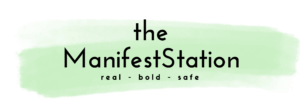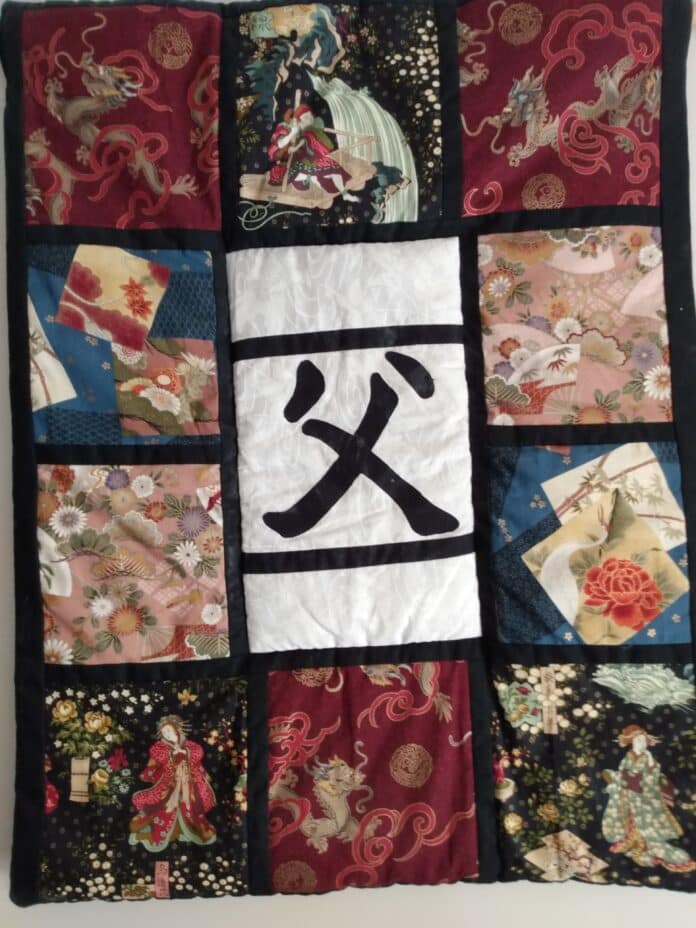It arrived in a bulky package about a year after my dad died. The wall hanging I’d made for him, from Asian-themed fabrics with the Japanese character for “father” in the middle. My mother had sent it back to me, why I’m not sure. Perhaps she thought I’d want a reminder of him, but it didn’t really remind me of him so much as of the time when I made it.
I was riding out a deep depression, trying to finish my PhD thesis while also keeping a grip on the everyday. Tasks that focused on using my hands were critical to maintaining that grip. I decided to try sewing fabric art; not quilts, as I wasn’t interested in log cabin blocks and rotating windmills. I just wanted to translate an image from my head onto the fabric, and have it mean something.
I’m not sure why I chose to sew a wall hanging. I hadn’t really sewed since high school, when I bought secondhand bell bottoms and stitched them into straight-legged pants. I had no experience with selecting colours, cutting squares, or sewing strips of fabric together in a straight line. I hadn’t read about quilting or taken any courses. I was just experimenting, letting my mind wander in any direction it wanted.
I started with the idea of making something for Father’s Day. My dad was deep into Japanese culture at the time, going to Saturday school to learn to read, write, and speak the language, and practicing his hard-earned phrases on visiting Japanese dignitaries. I thought he’d appreciate something with a Japanese flair.
At the fabric shop I picked out my favourite designs: slithery dragons on a burgundy background, women in traditional Japanese dress surrounded by trees and waterfalls on a black background, squares of gold with flowers dusted on top on a blue background, white fabric with an embossed bamboo pattern, and open fans and flora floating on a bronze background. I had no idea what I was going to make, but the fabric was a tactile beginning, a way of envisioning the piece before I sat down to do the actual sewing.
I settled on a simple rectangle for the wall hanging, with the short edge at the top. Three squares across and four squares down, with the middle column divided into a square, a rectangle, and another square. The rectangle is where the character for father would go, in the middle of the piece, on top of the white fabric with the embossed bamboo pattern.
I set myself up at the dining room table, the fabric in a pile beside me, my workhorse 1970s-era Pfaff sewing machine in front of me. I cut and sewed, sewed and cut. It calmed my mind and opened a space where there was no depression, just endless time and quiet. The sound of the sewing machine was soothing, like that of waves on a beach. I cut and sewed, sewed and cut. Slowly the wall hanging began to take shape in my hands.
I made it for both of us.
For me it was the consistency of working slowly at a small project and seeing it come together slowly in my hands. It was the quiet time in my head, calculating measurements and cutting fabric to match. It was the rotary cutter, sharp as a razor blade and likely doubly as dangerous, which I handled with care. It was the music I played while sewing: The Be Good Tanyas, turned up loud and on repeat.
For him it was meant to be a celebration of Father’s Day, a way to show that I loved him even if I didn’t always say so—or act like it. A way to connect us across the long distance between Vancouver Island and Ottawa, across the gap between our annual visits.
*
When I was a child, we went on long summer road trips. My dad told me stories as we drove, about gnomes and other creatures who lived in the woods. Once we got to our evening campsite, I was afraid to go into the woods for fear of meeting them.
These days it’s my mental forest I avoid, the place where all the emotions I’ve packed away hide amongst 90 foot trees bigger around than my arms can reach. I hesitate to enter it because I don’t want to meet whatever shape my grief has taken. I might encounter a steep drop, a thorny thicket, or a raging beast. So maybe I’ll just let it be. Hang on to the idea that my dad’s still out there. That I just haven’t seen him in a while or managed to get him on the phone. He might be at a conference, or on a trip to South America. If I send him an email, he might reply with something he’s read out of Scientific American or American Scientist.
But the forest doesn’t lie. All of those options are gone now. What’s left is this wall-hanging. Three squares across and four squares down. With the symbol for father in the middle.
*
My dad always had to have a goal. He earned his PhD in geochemistry in England in the 1960s. After he retired, he did a Master’s degree in international development and a PhD in sociology. He travelled to South America regularly for both work and pleasure. He became laser-focused on corporate social responsibility in the mining industry, publishing articles and books and attending international conferences about it. In between, he worked on his 1978 VW van with the help of his mechanic neighbour.
For most of his career he was a bureaucrat, but not in the pejorative sense of the word. Maybe it was his philosophical bent, his constantly flyaway hair, or his varied interests that made him someone people wanted to talk to and interact with—and he sure loved to talk. He was happy to chat with anyone about anything, no matter how personal, because he was interested in everything around him. Even though my mom told him, “the cab driver is not your best friend,” he would talk the man’s ear off anyway.
My dad died in July of 2020. He was almost 80 years old, remarkable for a Type 1 diabetic. He had just recovered from a stroke and come home from being in rehabilitation for four weeks. Because of COVID, he had spent his first two weeks at the rehab facility in isolation, pacing around his room or walking up and down the hallway to get exercise. During his time in rehab he never stopped texting and chatting with his collaborators, planning for a presentation at a conference in August (my mom suggested someone else give it), and reading magazines and newspapers dropped off by kind friends.
On his fifth day back home, he had another stroke. This was the big one, the one from which he’d never recover. The one that said, “Okay, it’s time to go now.”
Because of both the pandemic and being in another deep depression, I couldn’t be there to say goodbye. It’s been almost five years now and I still regret not taking the risk and flying out for his time in hospice, when he finally relaxed and slowly passed into the netherworld. I could have held his hand, touched his face, and watched his breaths get slower and farther apart. My mom and my sister were there, and my sister held her phone to my dad’s ear so I could speak to him. But he couldn’t respond as he was already drifting away, into the woods with the gnomes and other creatures.
In the absence of a physical memory of saying goodbye, I have to remind myself regularly that my dad is gone. Really and truly gone. I will never talk to him or see him again. There is nothing left of him here—I scattered some of his ashes in an evening campfire, a tribute to all of our camping trips together. The rest I left on a mossy stump in the woods, which had amazed him. “Look at the trees! They’re so tall!” he’d marvelled.
Maybe my mom sent me the wall hanging as a way to bring him back, a tangible object that was for and about him, something that I can look at and remember not only the making of it, but the man for whom it was made. Maybe she was thinking of me, and meant it to be a kind gesture that acknowledged our shared grief.
Because we are, all of us—my mom, my sister, and I—bereft, lost. We are grieving a life not just gone, but the futures that life will never experience. He has missed everything that has happened to us since July 22, 2020. He has missed not just our birthdays but his own. He’s missed his wedding anniversary, and the loss of my beloved dog, Cosmo, not 2 months after he passed away. He’s missed trips to Holland to see family and to the UN to present his research. He’s missed Christmases, and Father’s Days, and even the unremarkable days in between where nothing much happens but there’s always something to talk about.
As Kathryn Schulz writes in Lost & Found, “…loss…encompasses, without distinction, the trivial and the consequential, the abstract and the concrete, the merely misplaced and the permanently gone.”
The only positive about my dad’s death is that he left us when he was in his prime: mentally alert, physically active, and enjoying life, though he and I talked often about the state of the world and he said he was glad he wouldn’t live to see the future, which he thought was a bit grim both politically and environmentally. He and my mom drove regularly to the eastern United States on holidays, to see the fall colours in Vermont and buy American cheddar. To visit local secondhand stores, one of their favourite pastimes.
What am I supposed to do without a dad?
I remember the story about him flicking the switch for the bathroom light and it didn’t go on. He went to the hardware store to get a new switch, installed it, and the light still didn’t work. Turns out the bulb had burned out. He had automatically assumed the complicated answer: that the switch was broken, than the more likely answer: that the bulb was burned out.
There is a simple answer to my question: what do I do without a dad? I step into the forest, into the maze of trees. Stop being afraid and start walking forward. Three squares across, four squares down. With my father in the middle.
***
The ManifestStation publishes content on various social media platforms many have sworn off. We do so for one reason: our understanding of the power of words. Our content is about what it means to be human, to be flawed, to be empathetic. In refusing to silence our writers on any platform, we also refuse to give in to those who would create an echo chamber of division, derision, and hate. Continue to follow us where you feel most comfortable, and we will continue to put the writing we believe in into the world.
***
Our friends at Corporeal Writing are reinventing the writing workshop one body at a time.
Check out their current online labs, and tell them we sent you!
***
We are looking for readers with an hour or so a week to read non-fiction submissions.
Interested? Let us know!
***
Inaction is not an option,
Silence is not a response
Check out our Resources and Readings if you agree.



